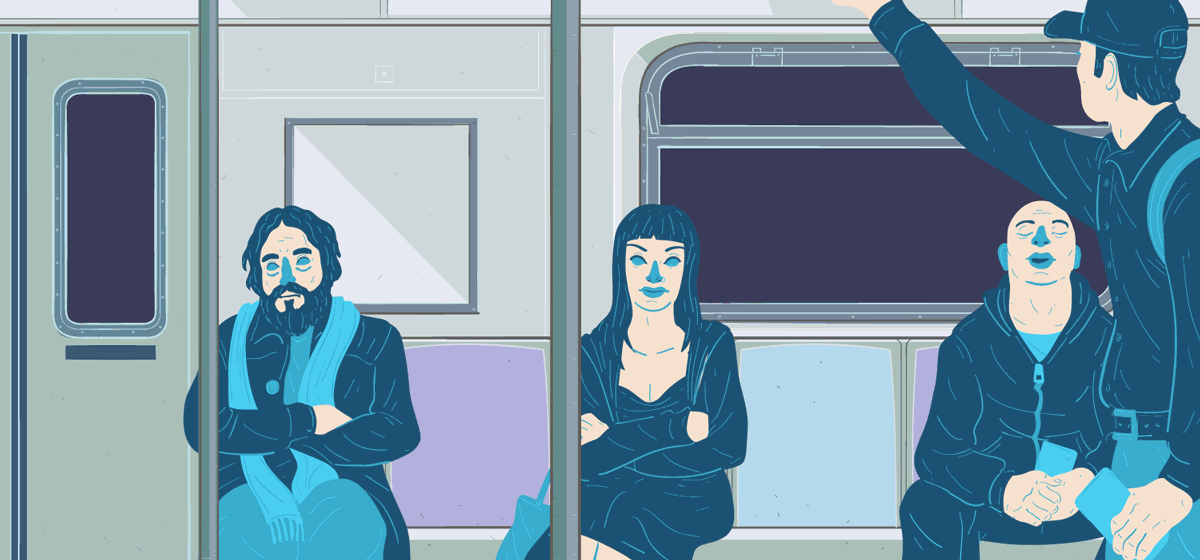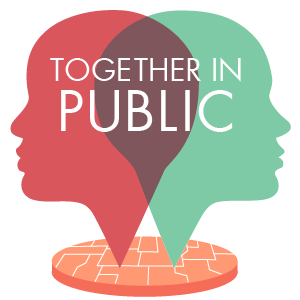

There’s a book I love, China Miéville’s weird fiction/detective noir novel The City and The City, that uses shared and unshared public space as a narrative device.

Two cities, Besźel and Ul Qoma, have been split between neighboring countries going back hundreds of years; but unlike cross-border cities like Detroit-Windsor or Kinshasa-Brazzaville, the two cities are interwoven in the book. Essentially it’s a more outrageous version of real-world examples like the formerly enclave-riddled India-Bangladesh border.
The two countries, and cities, have long been enemies, developing distinct customs and traditions over the centuries. Traveling from one to the other is strictly forbidden, but the border isn’t just a physical line–it’s metaphysical, too. There’s a supernatural division between the two peoples. Physically crossing the border can, in some cases, be as easy as moving from one side of a room to another. There are other ways to cross, though, for instance by failing to ignore things and people you shouldn’t be able to see. In one passage a character from Besźel sits in his kitchen, enjoying the silence after a long day at work; outside of his window, in a completely different reality, a loud, screeching Ul Qoman elevated train rushes past.
In this world, the people who occupy the same physical spaces, breathe the same air, and seek shelter from the same rains are separated by more than just language and culture. Each person moves through the world like a shadow to those next to them, flickering in and out of existence.
If someone chooses to break the wall between the two worlds–to stare at the ghosts that surround them–it’s a source of conflict, a violation of civil norms, and a crime. The book itself is a murder-mystery romp about a suspect who commits murders in both cities with impunity; but it’s also, now, a metaphor for our times.
In our Together in Public section, we explore how people who share physical and digital spaces connect–or don’t connect. This is, after all, how echo chambers or filter bubbles work. But if we concentrate, and look at just the right angle, we can spot those ghosts who exist right next to us, living parallel yet different lives.
In a conversation about public space, it’s always tempting to talk about the physical and digital realms as two different things. But that’s a false binary. Public space, in the traditional, town-square sense, is always under assault from those who wish to control it for themselves–but that applies just as much when those town squares are, say, in a videogame or on social media. And logging off isn’t the same as an undo button; conflicts online are as real as those that happen in person.
How can we make sure that when new groups come together in these spaces the result is cooperation, not conflict? This reading list contains sources we feel are worth reading, watching, and hearing to get a beginner’s grasp of this topic.

“It is wrong to say “‘IRL’ to mean offline: Facebook is real life.”

Start here (with our staff recommendations)
- Ian Steadman: “Why Youth (Heart) Social Network Sites: The Role of Networked Publics in Teenage Social Life,“ danah boyd
“Even though she doesn’t explicitly name it here, this paper is a great introduction to a phrase and concept boyd is an expert on–”‘context collapse.’ Instead of being able to adjust our social behavior to contextual clues, as in real-world interactions, the internet gives us an audience of infinite expectations. This 2007 study of teen behavior on social media (later expanded into a book) feels ever more relevant with each new tweetstorm.” - Abigail Ronck: Marina Abramovic: The Artist Is Present
“Even more than the MOMA exhibit that has her staring for hours on end into the eyes of strangers, I was struck by this documentary’s retrospective of her work–so much of it is about bodies crashing into each other. It’s interesting to think where that’s gone or whether it ever existed in proper society at all. We crash into each other emotionally every day, but I found myself surprised by the brutal physical manifestation of that.” - Duncan Geere: “An Amateur vs. ISIS: A Car Salesman Investigates and Ends Up in Prison,“ Scott Shane, The New York Times
“In modern society, the commons has been largely replaced by the comments. This fantastic New York Times story shows what happened when one man delved too deep.” - Kristen Taylor: Why We Cooperate,“ Michael Tomasello
“Now feels like a good time to think about altruism and motives and how culture shapes our collective behaviors.” - Matt Locke: “Did Media Literacy Backfire?,“ danah boyd
“A piece I wish we’d commissioned from danah. I worked in media literacy projects at the BBC and Channel 4, and always felt we were using 20th-century tactics to solve a 21st-century problem. danah explains this very well indeed.”

Physical spaces
Again, let’s acknowledge that this binary–between physical and digital space–isn’t necessarily a real one. That said, it makes intuitive sense for people to approach the topic this way and helps to break down this reading list. The following books and articles are either about things we can touch, or about spaces in which we can touch things.
- “Cities for People, Not for Profit: Critical Urban Theory and the Right to the City“
Edited by Neil Brenner, Peter Marcuse, and Margit Mayer - “The Death and Life of Great American Cities“
Jane Jacobs - “Radical Cities: Across Latin America in Search of a New Architecture“
Justin McGuirk - “The Great Good Place: Cafes, Coffee Shops, Bookstores, Bars, Hair Salons, and Other Hangouts at the Heart of a Community“
Ray Oldenburg - “Sidewalk City: Remapping Public Space in Ho Chi Minh City“
Annette Miae Kim - “Free Spaces: The Sources of Democratic Change in America“
Sara M. Evans and Harry C. Boyte - “Making the Memorial“
Maya Lin, The New York Review of Books [10-minute read] - “London’s Overthrow“
China Miéville, originally published in the The New York Times [20-minute read] - “A Low and Distant Paradise“
Rahawa Haile, Pacific Standard [9-minute read] - “Escape From New York“
Ellen Willis, The Village Voice [20-minute read] - “Unfriendly Climate“
Sonia Smith, Texas Monthly [10-minute read]

Digital spaces
The other half of the digital-physical binary, where human hands move electrons around, is a place where words are just as real as sticks and stones.
- Life on the Screen: Identity in the Age of the Internet
Sherry Turkle - “The IRL Fetish“
Nathan Jurgenson, The New Inquiry [7-minute read] - “Inside Facebook’s (Totally Insane, Unintentionally Gigantic, Hyperpartisan) Political-Media Machine“
John Herrman, The New York Times Magazine [15-minute read] - “Get Rich or Die Vlogging“
Gaby Dunn, Fusion [12-minute read] - “A Short History of the Horde: How Ta-Nehisi Coates Built the Best Comment Section on the Internet–and Why It Can’t Last“
Eva Holland, Longreads [7-minute read] - “Get Up, Stand Up: Social Media Helps Black Lives Matter Fight the Power“
Bijan Stephen, Wired [10-minute read] - “How I Created a New Digital Identity (And You Can Too)“
Patrick Howell O’Neill, Daily Dot [5-minute read] - “Locking Down Your Digital Identity“
Center for Solutions to Online Violence, Femtechnet [4-minute read] - “I Used to Be a Human Being“
Andrew Sullivan, New York Magazine [10-minute read] - “Revenge of the “‘Nerds’: Collective Action Against Intellectual Property Maximalism in the Global Information Age“
Susan K. Sell, International Studies Review - “The Secret Lives of Tumblr Teens“
Elspeth Reeve, The New Republic [15-minute read] - “‘Internet Famous’: Visibility as Violence on Social Media“
Shanley Kane, Model View Culture [6-minute read] - “Diary“
Emily Witt, London Review of Books [7-minute read]

Watch and listen
If the internet’s destroyed your attention span, then this section may help.
Lo and Behold: Reveries of the Connected World
Director Werner Herzog’s 2016 feature-length documentary is both a history of “the biggest revolution we as humans are experiencing” and a scattershot investigation into how the physical world is mutating under a digital gaze.
The Social Life of Small Urban Spaces
A classic 1980 film by urbanist William H. Whyte–perhaps the classic film on urbanism–which seeks to answer one question: “What makes good public spaces work and others not?”
Life in a Day
Compiled from footage submitted online by people around the world, Life in a Day is sold as a documentary made up only of video clips recorded on July 24, 2010. It’s effectively a feature-length adaptation of any time you’ve been bored and spent an hour or so clicking around randomly through YouTube. Alternately mundane and compelling, this 2011 film could only exist because of the internet and our devotion to watching “real lives.”
NPR’s Code Switch podcast
A show that includes consistently excellent discussions on race, identity, and culture, and what happens when those things overlap.
BuzzFeed’s Internet Explorer podcast
Ryan Broderick and Katie Notopoulos “explore the weirdest corners of the internet so you don’t have to.” A crash course in memes.


How We Get To Next was a magazine that explored the future of science, technology, and culture from 2014 to 2019. This article is part of our Together in Public section, on the way new technologies are changing how we interact with each other in physical and digital spaces. Click the logo to read more.
